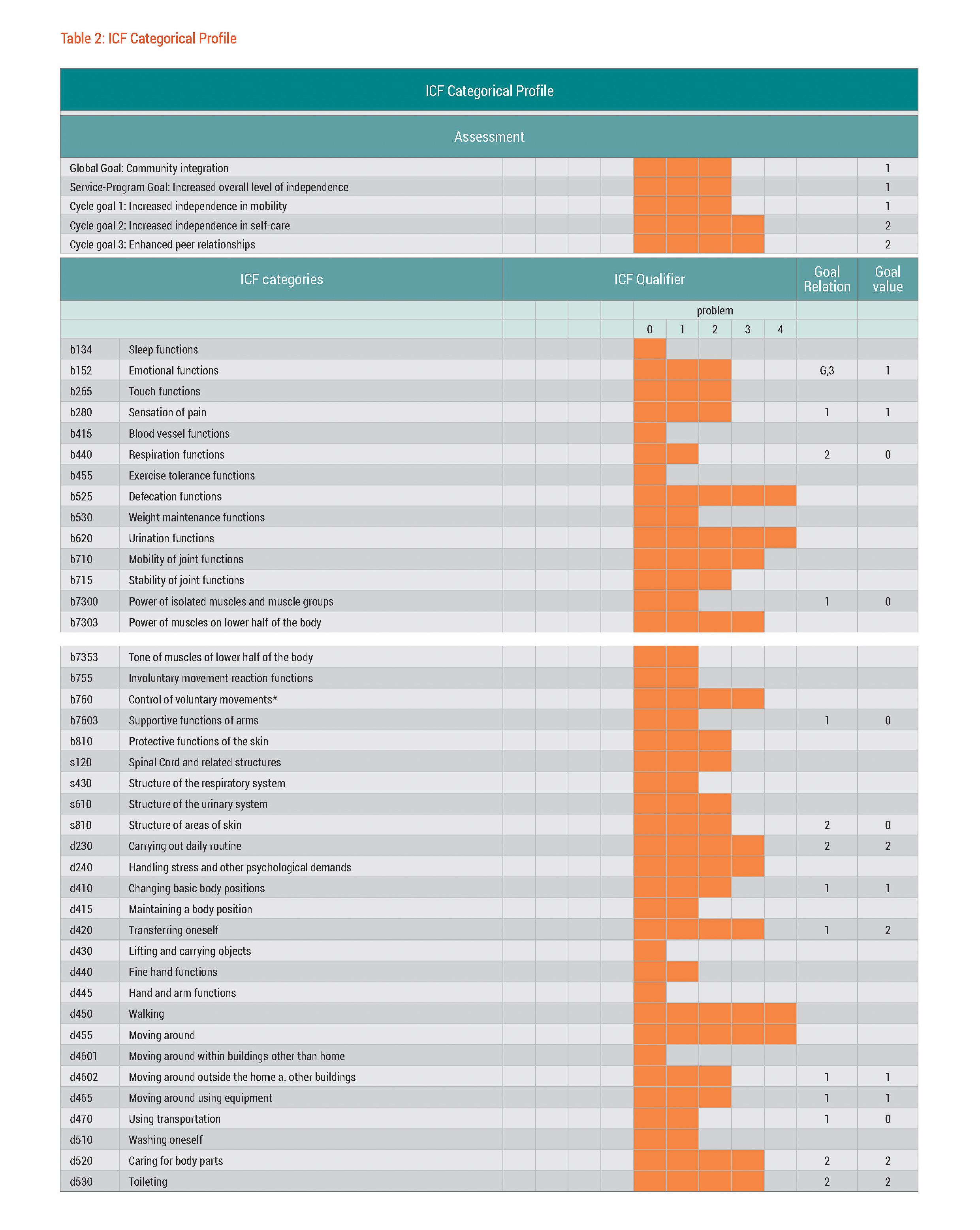Goal-setting/Determining Intervention Targets
Based on the results of the assessment, Gabi and her rehabilitation team set ‘community integration’ as the global goal. Although not explicit, this also included improvement in peer relationships. To help achieve the global goal, a service-program goal, that is, the goal to achieve at the end of this Rehab-Cycle®, was defined as ‘increased overall level of independence’. In turn, as small steps toward reaching the service-program goal three cycle goals – ‘increased independence in mobility’, ‘increased independence in self-care’, and ‘enhanced peer relationships’ were set. These goals were documented on the ICF Categorical Profile. In addition to the goals, the ICF Categorical Profile lists the corresponding categories of the International Classification of Functioning, Disability and Health (ICF){cs13-fn15} that correspond to the aspects of functioning identified during the initial assessment of Gabi's functioning.
The extent of the problem Gabi had in the respective ICF categories was visually displayed with a bar graph that reflected the rating given using ICF qualifiers. To help compare Gabi's functioning at the initial assessment and at a later time point, ICF qualifiers were also used to indicate the goal value i.e. the ICF qualifier that was intended to be reached after the intervention phase. See table 2.

Table 2: ICF Categorical Profile; ICF Qualifier: rate the extent of problems (0 = no problem to 4 = complete problem) in the components of body functions (b), body structures (s), activities and participation (d) and the extent of positive (+) or negative impact of environmental (e) and personal factors (pf); Goal Relation: 1, 2, 3 refers to Cycle goal 1, 2, 3; SP refers to Service-Program Goal; G refers to the Global Goal; Goal value refers to the ICF qualifier to achieve after an intervention.
""While emotional functions referred to Gabi's feelings and her ability to control them, complex interpersonal interactions and informal social relationships referred to her behaviour toward others, particularly peers, and how she interacted with them.""
The ICF categories (and personal factors) that corresponded to any of the goals set and were associated with a goal value were considered intervention targets. Intervention targets were those categories intended to be addressed with specific interventions. For example, for cycle goal 3 ‘enhanced peer relationships’ Gabi and her rehabilitation team defined the following intervention targets: b152 Emotional functions, d720 Complex interpersonal interactions and d750 Informal social relationships. While emotional functions referred to Gabi's feelings and her ability to control them, complex interpersonal interactions and informal social relationships referred to her behaviour toward others, particularly peers, and how she interacted with them. The personal factors of social competencies and assertiveness were also designated as intervention targets.
At the time of the initial assessment these personal factors neither enabled nor hindered Gabi in her interactions and relationships with others. However, Gabi and the rehabilitation team decided that these personal factors should become facilitators at the end of the Rehab-Cycle®. Social competencies and assertiveness were seen as skills and personal traits that supported positive relationships and interactions with others. Although not specified on the ICF Categorical Profile, the intervention targets for cycle goal 3 were intended, among other things, to support Gabi's management of stress related to her interactions with non-wheelchair using peers at school.
""Social competencies and assertiveness were seen as skills and personal traits that supported positive relationships and interactions with others.""
To assist Gabi in addressing these intervention targets a psychologist was invited to join the rehabilitation team. The psychologist was one of a team of eight health professionals who provided interventions in the next stages of the Rehab-Cycle®.